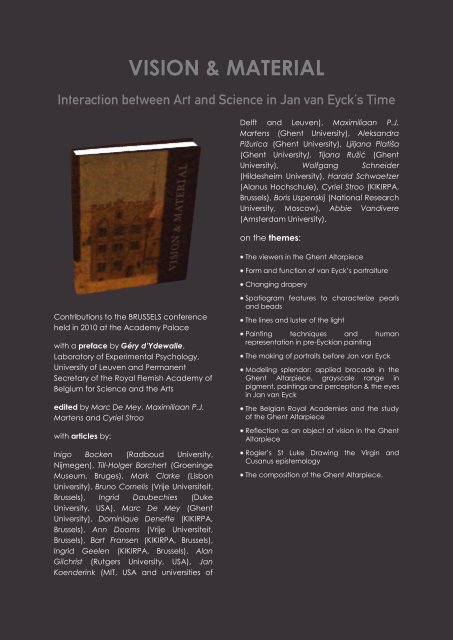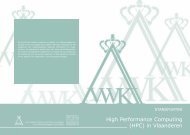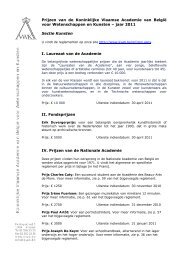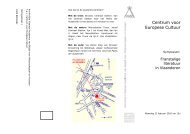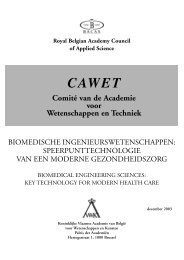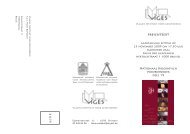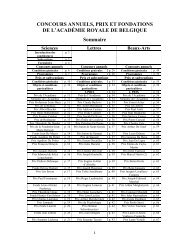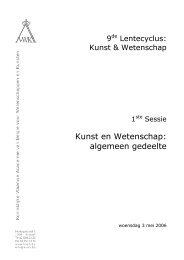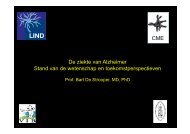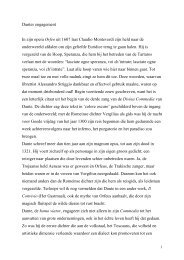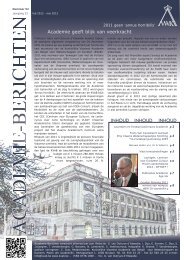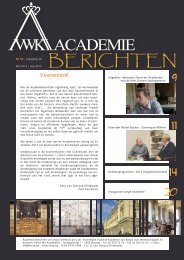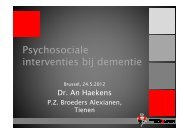VISION & MATERIAL
VISION & MATERIAL
VISION & MATERIAL
You also want an ePaper? Increase the reach of your titles
YUMPU automatically turns print PDFs into web optimized ePapers that Google loves.
<strong>VISION</strong> & <strong>MATERIAL</strong><br />
Interaction between Art and Science in Jan van Eyck’s Time<br />
Contributions to the BRUSSELS conference<br />
held in 2010 at the Academy Palace<br />
with a preface by Géry d’Ydewalle,<br />
Laboratory of Experimental Psychology,<br />
University of Leuven and Permanent<br />
Secretary of the Royal Flemish Academy of<br />
Belgium for Science and the Arts<br />
edited by Marc De Mey, Maximiliaan P.J.<br />
Martens and Cyriel Stroo<br />
with articles by:<br />
Inigo Bocken (Radboud University,<br />
Nijmegen), Till-Holger Borchert (Groeninge<br />
Museum, Bruges), Mark Clarke (Lisbon<br />
University), Bruno Cornelis (Vrije Universiteit,<br />
Brussels), Ingrid Daubechies (Duke<br />
University, USA), Marc De Mey (Ghent<br />
University), Dominique Deneffe (KIKIRPA,<br />
Brussels), Ann Dooms (Vrije Universiteit,<br />
Brussels), Bart Fransen (KIKIRPA, Brussels),<br />
Ingrid Geelen (KIKIRPA, Brussels), Alan<br />
Gilchrist (Rutgers University, USA), Jan<br />
Koenderink (MIT, USA and universities of<br />
Delft and Leuven), Maximiliaan P.J.<br />
Martens (Ghent University), Aleksandra<br />
Pižurica (Ghent University), Ljiljana Platiša<br />
(Ghent University), Tijana Ružić (Ghent<br />
University), Wolfgang Schneider<br />
(Hildesheim University), Harald Schwaetzer<br />
(Alanus Hochschule), Cyriel Stroo (KIKIRPA,<br />
Brussels), Boris Uspenskij (National Research<br />
University, Moscow), Abbie Vandivere<br />
(Amsterdam University).<br />
on the themes:<br />
The viewers in the Ghent Altarpiece<br />
Form and function of van Eyck’s portraiture<br />
Changing drapery<br />
Spatiogram features to characterize pearls<br />
and beads<br />
The lines and luster of the light<br />
Painting techniques and human<br />
representation in pre-Eyckian painting<br />
The making of portraits before Jan van Eyck<br />
Modeling splendor: applied brocade in the<br />
Ghent Altarpiece, grayscale range in<br />
pigment, paintings and perception & the eyes<br />
in Jan van Eyck<br />
The Belgian Royal Academies and the study<br />
of the Ghent Altarpiece<br />
Reflection as an object of vision in the Ghent<br />
Altarpiece<br />
Rogier’s St Luke Drawing the Virgin and<br />
Cusanus epistemology<br />
The composition of the Ghent Altarpiece.
On the jacket: Front and back together:<br />
the detail (slightly enlarged) of the City<br />
View from the Annunciation Scene of<br />
Hubert and Jan van Eyck, The Adoration of<br />
the Lamb (Ghent Altarpiece), closed<br />
polyptych (width of the depicted view on<br />
the original: 30,2 cm, on the jacket 34,2<br />
cm)<br />
Three barely visible viewers (6 mm in<br />
height) at the city gate in the city view of<br />
the Annunciation scene in the Ghent<br />
Altarpiece face the divine light. They are<br />
positioned in a horseshoe pattern and only<br />
the fellow furthest in the street fully<br />
captivates the light making his companion<br />
in the middle visible through some<br />
backlight and some reflected light from<br />
the hidden side of the silhouetted fellow<br />
who is nearest. The outline of the latter’s<br />
face and chest is shown by the whitish line<br />
indicating sideways shattered light. Vision<br />
issues and optical sophistication belong to<br />
Jan van Eyck’s favourite topics and<br />
techniques. He is eager to represent<br />
onlookers in a depicted scene as is evident<br />
from the figures reflected in the mirror of<br />
the Arnolfini Double Portrait (National<br />
Gallery, London). Other paintings contain<br />
them too, sometimes subtly hidden as in<br />
the Bruges’ The Virgin and Child with<br />
Canon Van der Paele. The three observers<br />
in the back of the city scene of the Ghent<br />
Altarpiece have been the subject of much<br />
exploration at VLAC and were chosen as<br />
the emblem for a 2010 conference on the<br />
Eyckian fascination with vision<br />
complementary to his penetrating<br />
understanding of light’s interaction with<br />
the surface of materials, hence the theme<br />
and the title <strong>VISION</strong> & <strong>MATERIAL</strong>.<br />
The achievement of the Ghent Altarpiece<br />
coincides with Leon Battista Alberti’s<br />
writing of De Pictura (On Painting), a<br />
turning point in the history of art. The<br />
treatise applies the late medieval science<br />
of vision (optics) which Jan van Eyck<br />
equally appears acquainted with, but<br />
which he pursues in another direction than<br />
Alberti. This collection contains<br />
presentations at the Brussels <strong>VISION</strong> &<br />
<strong>MATERIAL</strong> conference of 2010 that follow<br />
through on the exploration of the theme<br />
interaction between Art and Science in<br />
Jan van Eyck’s Time.<br />
The book <strong>VISION</strong> & <strong>MATERIAL</strong> published September 2012 by the Royal Flemish Academy of<br />
Belgium comprises 332 pages format 22 x 29 on 150 g paper and is clothbound with an<br />
illustrated jacket; it contains 180 illustrations, mostly full colour and many full page.<br />
Plates and figures for the Ghent Altarpiece are based on the photographs taken during the<br />
2010 extensive research campaign directed by professors Anne van Grevenstein (Amsterdam<br />
University) and Ron Spronk (Queen’s University, Canada, and Radbout University, Nijmegen)<br />
accessible via http://closertovaneyck.kikirpa.be.<br />
Order on http://www.kvab.be/publicaties/boekdetail.aspx?id=2434


